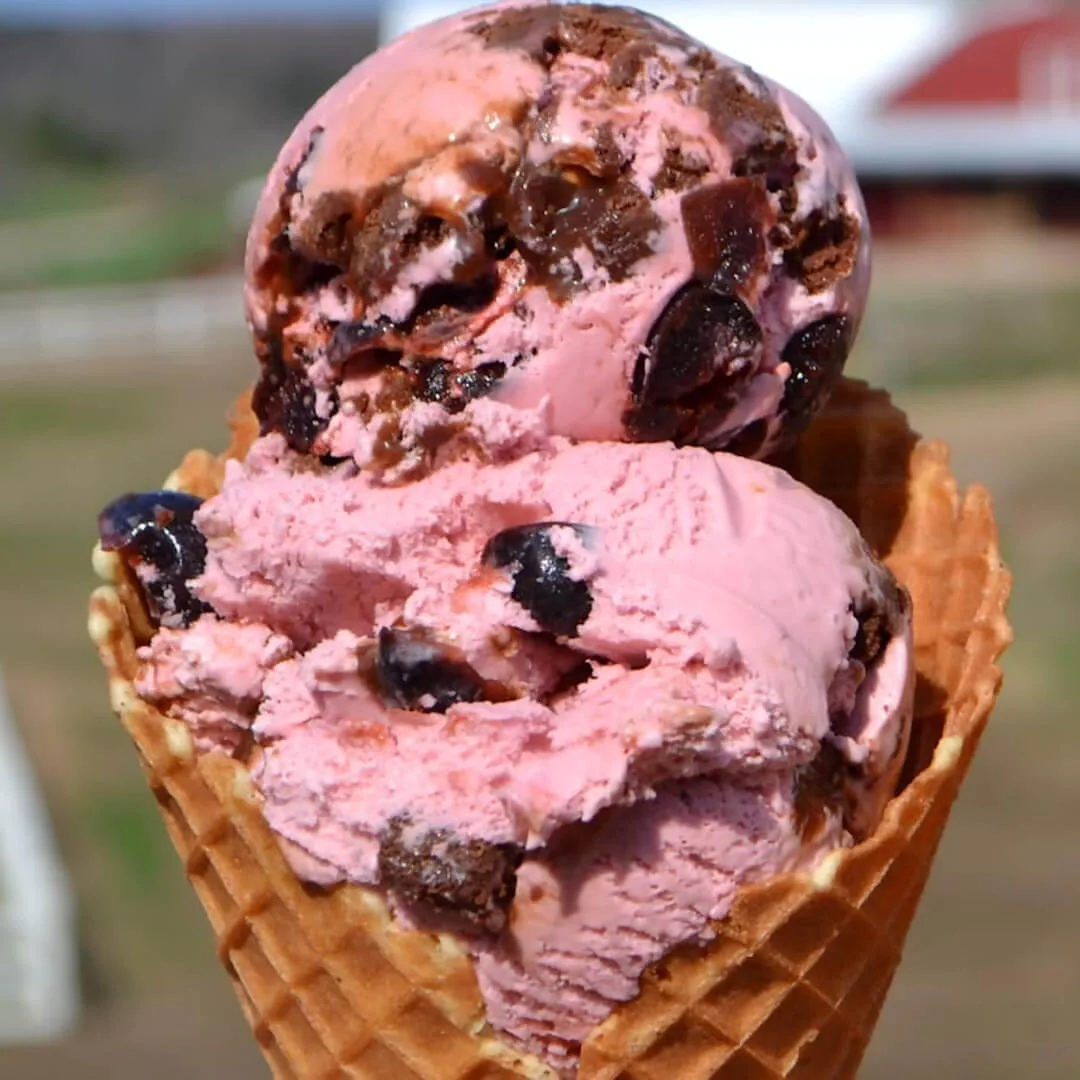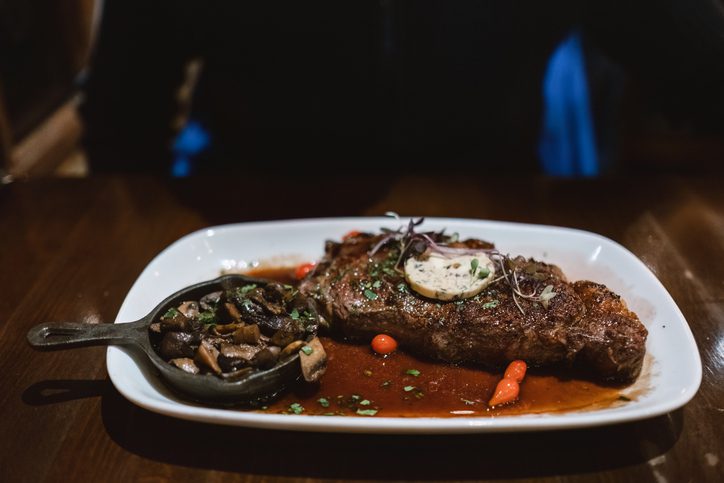
Photo courtesy of Moomers Homemade Ice Cream via Facebook
A Michigan summer may be brief, but there’s plenty to eat while we’re in it.
MICHIGAN — It’s summer again in Michigan, and that means everything seasonal is returning — food included.
As the state with the second-greatest crop diversity in the country, we take our food seriously in the Mitten State. From cherries, strawberries, and blueberries to asparagus, cucumbers, and squash, the locally-available culinary opportunities are limited by little more than our imaginations.
Michigan is home to agricultural diversity thanks in large part to its cultural diversity. Going back more than 100 years, immigrants and cultural communities have left their delicious mark on the state’s cuisine. For foodies, wannabe foodies, and foodie dabblers, there’s a lot of culinary experiences to discover, especially in the summer.
We’ve put together a list of our favorite summer foods both traditional and new.
Michigan Sweet Corn

Whether it’s grilled in the husk, roasted, steamed, boiled, or baked, sweet corn is the summertime side in Michigan. Not only does it make the perfect companion for summer barbecues and cookouts, it’s usually inexpensive and locally distributed.
Sweet corn is a cuisine of the Americas, originally developed by the indigenous natives. Native Americans often used the “Three Sisters method” of planting, which meant companion-planting corn, beans, and squash for maximum yield. That method is still utilized by gardeners today.
In particular, sweet corn results from a gene mutation that produces less starch and twice as much sugar as other corn varieties. Michigan’s sweet corn is especially sweet, since Michigan’s cooler nights result in greater sugar accumulation and sweeter corn.
About 10,000 acres of Michigan farmland are devoted to sweet corn, which is typically in season between July and October. There are more than 60 different varieties of sweet corn available, including Jubilee, Peaches and Cream, Silver Queen, and more.
Check out the Michigan State University Extension website for the best tips for using, storing, and preserving sweet corn. Or visit the Michigan Farmers Market Association website to find a farmers market that sells sweet corn near you.
Better Made Potato Chips

If you’re at a summer cookout in Michigan, odds are pretty good that your burger or hot dog will be accompanied by Better Made potato chips.
Better Made Snack Foods is a Detroit company with nearly a century of quality snacking history. The company’s food is perhaps best known for its freshness, boasting that they’re able to turn a potato into chips in just seven minutes. Detroiters can buy directly from the company when the chips are only a few hours old. Michigan-grown potatoes are used as much as possible, with out-of-state potatoes only used in the two months that potatoes are not available in Michigan.
The company was founded by Sicilian immigrants Cross Moceri and Peter Cipriano in 1934, a rebranding from their previous company Cross and Peters, founded four years earlier. Better Made has been the better brand, standing the test of time while competing against other Detroit potato chip manufacturers like Frito-Lay and, at one point, as many as 20 other potato chip manufacturers in the city. This competition encouraged Better Made to offer its first flavored chip, barbecue, in 1973. Today, Better Made is the only Michigan potato chip company, offering eight different flavors of chips in addition to other types of snacks like popcorn, cheese puffs, and more.
Throughout its history, Better Made has sold chips all over Detroit. When movie theaters were booming and concession stands hadn’t caught on yet, Better Made sold chips next door. They’ve even sold on Belle Isle, but they settled in their current location on Gratiot Avenue after World War II.
Until 2018, Better Made chips were only available in Michigan, but the chips were so popular that native Michiganders who had moved out of state were yearning for Better Made to make them available in their current towns. Better Made finally extended its product reach to 13 other states, mostly in the South and northeast.
Visit the Better Made Snack Foods website to order enough chips for your next summer party.
Bell’s Oberon Wheat Ale

Bell’s Oberon isn’t just any old Michigan beer; it has its own day named after it. Made an official holiday by Gov. Gretchen Whitmer in 2022, Oberon Day is celebrated by Michiganders every year at the start of spring. You can find Oberon anywhere beer is loved in Michigan, including on restaurant patios, aboard private boats, and in campsite coolers.
Bell’s Oberon is a wheat ale that, according to Bell’s official website, “embodies everything we love about summer.” The flavor profile is distinctly citrusy with bright and spicy hop flavors coming from Saaz hops. When served on draft, the Oberon usually comes garnished with a sun-like orange slice, but oddly enough, the original Oberon isn’t actually brewed with orange; the wheat and yeast just combine to make a citrus flavor. Mix in barley, and the Oberon has always been brewed with only four ingredients.
Oberon is more popular than any year-round beer produced by Bell’s Brewery. It’s so popular that, in May 2023, the brewery introduced a variety pack: Cherry Oberon, Citrus Oberon, and Mango Habanero Oberon. Both the cherry and mango habanero flavors had previously been released as special batches; most popular is the Mango Habanero Oberon, with over 16,000 ratings on Untappd.
Where did Oberon come from? Bell’s Brewery founder Larry Bell first brewed the wheat ale as a summer beer in 1992. It was called Solsun at that time, playing off both the solstice and the beer’s saison influence. The Solsun used Belgian malt, German hops, and American yeast for an eclectic and then-unknown flavor. The logo design was inspired by a sculpture Larry Bell found in the Muir Woods National Monument in California and the logo directly uses a face on a redwood carving by artist Tracey Allenberg.
In 1997, a Mexican brewery with similarly-named flagship beer El Sol opposed Larry Bell’s attempts to trademark Solsun. So, Larry Bell’s inspiration went in a different direction, to a theatre role he had played in the sixth grade: Oberon, the King of the Fairies from Shakespeare’s A Midsummer Night’s Dream. In this way, the new name still celebrated the coming of spring.
Visit the Beer Finder on Bell’s official website to find Oberon near you.
Burgers from Clyde’s Drive-In

Hamburgers aren’t just a staple of summer cuisine; they’re also an important part of Americana. Although traditions of drive-ins and carhops have mostly disappeared from America, Clyde’s Drive-In in St. Ignace keeps these old traditions alive within viewing distance of passing freighters along the Straits of Mackinac. And it helps that this timeless classic serves up what’s described as the best burger in the Upper Peninsula, right off the Mighty Mack.
Clyde’s Drive-In has a total of three locations, with additional locations in Sault Ste. Marie and Manistique. The burger joints are only open seasonally, making them true summer staples.
Clyde’s is notable for its carside service by actual carhops—a word for servers at drive-in restaurants for those too young to recognize it. The hamburgers are 100% beef and come in three sizes: junior, regular, and the famous Big C double-patty. The Big C is perhaps the most famous, weighing in at three-quarters of a pound. All the hamburgers are the “greasy spoon” variety of cuisine, but Michiganders and tourists alike can’t get enough.
The Drive-In is also a family-owned chain that you can feel good about supporting. The Sault Ste. Marie location is the original location, first opened by Clyde J. VanDusen in 1949. He opened the Drive-In after getting fed up with working for a boss on the town’s Sugar Island Ferry. VanDusen had a total of nine children between two wives and the whole family has been involved in running the business. It is currently owned by his daughter, Linda Jesionowski.
Check out Clyde’s Drive-In on its separate Facebook pages for the St. Ignace location, original Sault Ste. Marie location, and Manistique location.
Pronto Pup

They’re made in a mere 67 square feet of Grand Haven’s coast, and yet these beach snacks have been beloved by Michigan natives and tourists for over 70 years. Meet the Pronto Pup.
So what is it? The Pronto Pup is like a corn dog, but very different. Unlike corn dogs, which traditionally use cornbread batter on hot dogs, the Pronto Pup uses pancake batter to encase its hot dogs.
Pronto Pups are not uniquely a Michigan food; the snacks are also quite popular in Minnesota. But according to oral history, Pronto Pup creator George Boyington has Michigan ties. He got his start bootlegging liquor, smuggling the forbidden beverage into Michigan from Canada during Prohibition. He eventually cleaned up his act, moving to Oregon to become a concessions vendor and serve tourists.
As the story goes, Boyington became dismayed on Labor Day weekend 1939 when the rain ruined his stock of hot dog buns. He realized he needed a way to make his own hot dog buns spur-of-the-moment in such an emergency. Thus, he invented a deep-fried solution: the Pronto Pup. The Boyington family trademarked the Pronto Pup name in 1942 and Pronto Pups quickly spread east when Jack Karnis opened a franchise east of the Rockies in Chicago in the mid-’40s.
But things that are popular in Chicago often spread to Michigan’s west coast; so, too, did Pronto Pups. The Grand Haven Pronto Pup stand showed up in the harbor in 1947 and it’s been there ever since. The little food stand is considered a must-stop for beachgoers and otherwise during trips to Grand Haven.
The stand doesn’t sell much; it’s just Pronto Pups and Coca-Cola products, accepting cash only. And yet, it works so well that visitors come expecting a line. The little food stand has been an important part of trips, vacations, and childhoods for generations. As of 2020, Pronto Pups are also available in Grand Rapids via food truck.
Check out the Grand Haven Pronto Pup on Facebook.
Chicken Shawarma from Bucharest Grill

Summer is a great time to enjoy the nightlife of Michigan’s larger cities. But what’s the favored dish of Michiganders who are finishing their night on the town? According to a survey by Online-Casinos.com, Michigan’s favorite “drunchie” (drunk munchie) is the shawarma. Michigan was the only U.S. state to rank shawarmas first, with the Nunavet territory in Canada joining them in this craving. The reason why the shawarma ranked first is no doubt due to Detroit and its regional cuisine.
Shawarma is a Middle Eastern street food, technically referring to the rotisserie-style preparation method of the spiced meat. Shawarma dates back to the Ottoman Empire (modern-day Turkey) in the 18th century, but the word also refers to the dish itself, which has grown massively popular in the United States. Most commonly made as a wrap with cuts of shawarma meat, chicken is the most popular choice for Americans, especially since chicken is not typically used in the similar gyro.
Why is shawarma so popular in Michigan? Likely because Metro Detroit (and especially Dearborn) has the United States’ largest Arab American population — mostly made up of Palestinian, Lebanese, Iraqi, and Yemeni people.
Arab Americans began immigrating to the United States in the late 19th century. Like many immigrants, the Arab Americans were drawn to the opportunity to seek out potential for economic prosperity in America. Also like other immigrants, Arab Americans often wanted to escape impoverished conditions, which for them were spurred by the decline of the Ottoman Empire. The Arab American population nearly tripled after Henry Ford introduced the $5 work day in 1914, a significant wage for the value of a dollar in that era. Since then, the Detroit area has become a thriving community for Arab American people that continues to grow.
Arguably, there are many places in Metro Detroit to get the “best” chicken shawarma. But one of the best ones for late-night excursions to Detroit comes from Bucharest Grill, a fast-casual Middle Eastern restaurant with multiple locations. The chicken shawarma is their most popular offering, a recipe that was perfected by the restaurant over the course of three months. Bucharest Grill incorporates not just Middle Eastern techniques into the cooking, but also Romanian and American. The Bucharest Grill serves around 1,000 orders a day, mostly catering to the late-night bar crowd, sports fans from Comerica Park, and Detroiters working downtown.
Bucharest Grill originally opened inside Park Bar in downtown Detroit in 2006, located just around the corner from popular entertainment venues Fox Theatre and The Fillmore Detroit and down the street from Comerica Park and Ford Field. The current downtown location is a few streets over on Columbia Street, but it’s still open for late-night excursions, staying open until 1 a.m. on Fridays and Saturdays.
Almond Boneless Chicken from Paper Station Bistro

Harbor Springs is a lesser-known beach town on Little Traverse Bay, just across the water from Petoskey. But this hidden gem of a northern Michigan town has a big signature dish that visitors travel near and far to sample: the Almond Boneless Chicken, an entree that has a significant history in Detroit.
Chinese immigration was significantly altered by the Chinese Exclusion Act of 1882, which prevented most Chinese immigrants from entering the United States. However, thanks to a loophole in the legislation, a Chinese person could immigrate to the U.S. through a special merchant visa, provided they were ready to start a business in their new home. Thanks to this, many Chinese immigrants settled in Detroit—enough to start up the Chinatown neighborhood. And with these immigrants came new cuisine adapted from their home country’s culture. For Chinese immigrants in Michigan, that cuisine came in the form of the almond boneless chicken, or ABC for short.
ABC became a regional favorite of anyone who grew up in or around Detroit’s Chinatown. Though the dish’s origin is tough to nail down, it most likely originated from Columbus, Ohio. But since the Ohio versions of ABC have darker gravy with a stronger ginger flavor, Michigan’s take on ABC might just be our own, which has grown into a big part of both Detroit’s regional cuisine and the cuisine of Michigan as a whole.
Detroit’s former Chinese population have flocked to the suburbs for the most part, with the majority leaving after the Detroit uprising of 1967. Since then, the ABC has traveled across Michigan and won over the hearts of many a Michigander as a comfort food. The Paper Station Bistro opened in 2015 and quickly became one of the best restaurants in Michigan to try the noteworthy take on chicken, especially in the summer.
The Paper Station Bistro’s ABC is the restaurant’s most iconic dish, consisting of a tempura-coated and deep-fried chicken breast served over basmati rice and topped with chicken-based gravy, shredded lettuce, and almonds. Around 10% of the restaurant’s sales come from the ABC alone.
Visit the Paper Station Bistro on their website, Facebook page, or Instagram page for more info.
Whitefish Dip

Whitefish dip is a northern Michigan delicacy, especially for the summer. The creamy spread uses smoked whitefish that goes perfectly with bread, pita, or crackers. It’s optional whether you want lakeside views while enjoying whitefish dip, but it certainly helps.
Whitefish dip is made from smoked whitefish, usually mixed with a whipped cream cheese base and other ingredients. There are a variety of different ways to smoke whitefish, but it’s usually either hot smoked, with higher temperatures over the course of a day; or cold smoked, with lower temperatures over several days. This delicacy may be referred to as a dip, spread, pâté, or something else, but the only difference between these distinctions, if any, might simply be the consistency and intended manner of consumption.
The Great Lakes surrounding Michigan, especially Lake Superior, are plentiful with fish and fishing opportunities. Whitefish is one of the most popular and commonly harvested fish today. Before Michigan’s incorporation as a state, indigenous Native Americans in the Michigan territory—especially the Upper Peninsula—dried and smoked the local fish over fires. These smoked fish often got traded to French and English settlers.
By the 19th century, Norwegian immigrants began settling in northern Michigan, specifically Leland. They adopted the practice of smoking fish, which contributed to the popularity of Fishtown, a tourist destination on the Leland shores. Whitefish became the most in-demand fish thanks to Ashkenazi Jews in Detroit. The smoked whitefish dip was not just kosher, but similar to whitefish salad found in Jewish delis. And to really cinch it, the whitefish’s harvest season coincides with Jewish holidays.
You can find whitefish dip for sale in many locations across northern Michigan and the Upper Peninsula, as well as served as an appetizer in restaurants across Michigan. Michiganders debate greatly which one is best, but local favorites include Carlson’s Fish in the original Fishtown in Leland, Port City Smokehouse in Frankfort, and Manley’s Fish Market in St. Ignace.
Faygo Floats

Everyone loves ice cream floats. Michiganders love Faygo. So, a Faygo float? No brainer crowd pleaser in the Mitten. It’s a refreshing treating for any variety of summer happenings or just at home in your backyard.
There’s already a wide variety of ice cream floats enjoyed all over the country and the world once the weather gets hot. In Michigan, one of the most popular float varieties is the Boston Cooler, traditionally made using Vernor’s Ginger Ale and vanilla ice cream, with purists insisting the ice cream must be another Detroit brand name, Stroh’s. Other varieties of floats include root beer floats and Coke floats. But the Detroit-based pop company Faygo provides one of the easiest and most enjoyable ice cream floats there is.
It’s not surprising that Faygo mixes so well with ice cream. Russian immigrants Ben and Perry Feigenson started Feigenson Brothers Bottling Works, which would eventually become Faygo, in Detroit in 1907. The brothers were actually bakers that were inspired to create the first Faygo flavors from their most popular frosting flavors: strawberry, grape, and fruit punch.
If you’ve seen the Faygo-flavored ice cream invented by small-batch creamery Browndog Creamery, this epic collaboration came about more recently; the creamery sold Faygo floats during the COVID-19 pandemic after the company decided to design some ice cream using Faygo as a base, not just a mix-in. The result was “craft ice cream” that came in six flavors: Unicorn Swirl, Citrus Mist, Peaches & Creme, Motown Jam, Groovy Grape, and Choc & Rye.
It’s unknown how long Michiganders have been whipping up Faygo floats, but one thing is for sure; this is a recipe that chefs of any age can make. There are also a variety of restaurants, ice cream parlors, and food trucks serving up Faygo floats seasonally or full time.
Check out the Faygo website to find a number of flavor options for Faygo floats. If you decide to craft one in your own kitchen, it might be fun to sing “The Faygo Boat Song” while you do so.
Moomers Cherries Moobilee

Ice cream is far and away the most obvious choice for a summer treat. Michigan has plenty of delicious ice cream that it’s known for, including the three-flavor hybrid Superman, which originated using Blue Moon ice cream. But the absolute best of the best ice cream can be found at Moomers Homemade Ice Cream in Traverse City, which attracts visitors from all over the world.
USA Today named Moomers the Best Ice Cream Parlor in the country in 2016. In 2008, Good Morning America named Moomers America’s Best Scoops. Even President Biden had to drop by Moomers in 2021, after Michigan Sens. Gary Peters and Debbie Stabenow hyped up Moomers as “the best place in the world.”
Moomers signature flavor is the Cherries Moobilee, made from the local crop in Traverse City, known as “the Cherry Capital of the World.” Both sweet cherries and tart cherries come together to make the Cherries Moobilee so delicious, and the homemade brownie chunks and chocolate fudge swirl add the finishing touch. If you’re not a huge fan of cherries, don’t worry! Moomers has at least 20 flavors available every day, with over 150 rotating flavors, so you never have to eat the same flavor twice.
What’s the secret to Moomers’ success? A wholesome family-oriented, farm-to-table process focused on quality. Moomers is located on the Plummer family farm and you can watch the dairy cows graze as you enjoy your ice cream.
The company started in 1998 as a labor of love for Nancy Plummer, a first-grade teacher and mother of four. The family’s 80-acre dairy farm made a perfect place for a family business, which Nancy envisioned as a community gathering space that would employ youth in the local area. Since opening, two of Nancy’s children have also become involved in the family business.
Check out more about Moomers by visiting their website, Facebook page, or Instagram page.
Mackinac Chocolate Fudge

Fudge from Mackinac Island is the Michigan summer food that’s so popular, it has a specific term for the tourists (”fudgies”) who seek the delicacy out. During the tourism season, an average of 20,000 pounds of sugar every week go into making an average of 10,000 pounds of fudge per day. Fudge is the big business of Mackinac Island and business is booming. In 2018, Murdick’s Fudge released its top five most popular flavors, and the chart-topping flavor hit was classic chocolate!
Where did all this fudge come from? The first fudge shop on the island was Original Murdick’s Fudge. The Murdick family arrived on Mackinac Island in 1887, when it was a simple trading post. However, the island would shortly thereafter become a summer vacation destination thanks to its association with sweets—just a different kind of sweet: maple sugar.
The men of the Murdick family arrived as laborers, creating the canvas awnings for the brand new Grand Hotel. Matriarch Sara Murdick and her son, Rome, started Murdick’s Candy Kitchen. Though they didn’t invent fudge, they certainly popularized it for Mackinac Island. Rome pioneered the entertaining show of shaping cooling fudge for customers to watch. Other fudge shops soon followed suit, cashing in on the developing summer destination and competing with the fudge-cooling shows.
Today, there are 13 different fudge shops on the island, including May’s Candy Shop, Joann’s Fudge, and Ryba’s Fudge. Tasting Mackinac Island fudge is definitely a must-try activity that’s only available in the summer months. Fudgies and Michiganders alike disagree on which shop produces the best fudge, so it might be best to sample them all!
Visit the Mackinac Island official website for more information about its fudge shops.
READ MORE: Michigan’s Best-Kept Secret: Indulge in 8 Black-Owned Michigan Restaurants for a Soulful Experience

The Grand Rapids Food Guide: The best steak of 2025
In 2024, we asked readers to vote in the first ever Grand Rapids Food Guide and 1,200 votes decided on the Best Overall Restaurant. This particular...

The Grand Rapids Food Guide: The best burgers of 2025
To the folks of Grand Rapids, burgers are a point of pride, which isn’t a surprise in a town filled with Dutch and German immigrants who love their...

The Grand Rapids Food Guide: The best ice cream shops of 2025
Michigan is described as being a winter wonderland, and although this state experiences winter to the fullest, that doesn’t stop its residents from...

The Grand Rapids Food Guide: The best breweries of 2025
Grand Rapids is unofficially officially known as “Beer City USA,” so it’s not a shocker that the city is overflowing with breweries. When you’re...

The Grand Rapids Food Guide: The best grocery stores of 2025
When it comes to grocery shopping, everyone has their favorites. Some of us insist on the freshest produce, others hunt for money-saving deals. And...




